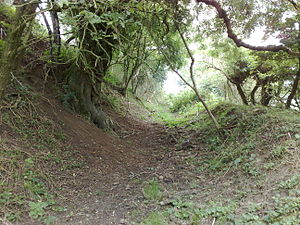Battle of Deorham
Coordinates: 51 ° 29 ′ 19.9 ″ N , 2 ° 22 ′ 6.3 ″ W.
The Battle of Deorham in 577 was a decisive confrontation between the British kingdoms of Britain and the Anglo-Saxons , who won the battle.
prehistory
The Gewissæ were a Saxon ethnic group who settled on the Upper Thames in England towards the end of the 5th century . Since the middle of the 6th century the Gewissæ expanded to the west: Cynric fought together with Ceawlin in the year 556 at Beranburh ( Barbury Castle ) against the Britons . After Cynric's death, his son Ceawlin succeeded him to the throne in 560. 571 mentions a victory by Cuthwulf over the Britons at Bedcanford ( Bedford in the Chiltern Hills ?) And the conquest of the cities of Limbury ( Bedfordshire ), Aylesbury ( Buckinghamshire ), Bensington ( Oxfordshire ) and Eynsham (Oxfordshire).
The battle and its aftermath
The site of the Battle of Deorham is now Dyrham, north of the city of Bath in Wiltshire . Around 577 the Gewissæ under Ceawlin and his son Cuthwine made an advance to the northwest. Presumably they initially occupied the old Iron Age fortification on the 200 m high Hinton Hill about 1 km north of Dyrham. In the battle that followed, the three British kings Coinmail (Cynvael), Condidan ( Cynddylan ) and Farinmail (Ffernvael) fell. The archaic forms of the name of the British kings suggest a very old, possibly contemporary, written tradition. The Gewissæ were able to conquer the southern part of Gloucestershire with the places Gloucester , Cirencester and Bath. With the conquest of these strategically important places, the Saxon settlement of the area could be secured. Ceawlin had thus succeeded in reaching the Severn and separating the British kingdoms of Wales and Cornwall . In the 7th century the conquered area came under the rule of Mercia .
swell
- anonymous: Anglo-Saxon Chronicle , online in Project Gutenberg (English)
literature
- HR Loyn: Deorham . In: Heinrich Beck (ed.): Reallexikon der Germanischen Altertumskunde , Volume 5 . de Gruyter, 1984, ISBN 978-3-11-009635-4 , pp. 319-320.
- Frank Merry Stenton: Anglo-Saxon England (Oxford History of England Vol 2), 3rd edition, Oxford University Press, 1971, ISBN 978-0-19-821716-9 .
- John Nowell Linton Myres: The English settlements . Oxford University Press, 1989, ISBN 978-0-19-282235-2
- Barbara Yorke : Kings and Kingdoms of Early Anglo-Saxon England . Routledge, London-New York 2002, ISBN 978-0-415-16639-3 . PDF (6.2 MB)
- Barbara Yorke: Wessex in the early Middle Ages (Studies in the Early History of Britain) , Continuum, 1995, ISBN 978-0-7185-1856-1 .
Web links
- William St. Clair-Baddeley: The Battle of Dyrham AD 577 (PDF; 317 kB) . In: Transactions of the Bristol and Gloucestershire Archaeological Society Vol. 51, 1929, pp. 95-101.
- TGP Hallett: The Battle of Deorham (PDF; 281 kB) . In: Transactions of the Bristol and Gloucestershire Archaeological Society Vol. 8, 1883-84, pp. 62-73.
Individual evidence
- ↑ Barbara Yorke: Certain . In: Lapidge et al. (Ed.): The Blackwell Encyclopaedia of Anglo-Saxon England . Wiley-Blackwell, Oxford et al. a. 2001, ISBN 978-0-631-22492-1 , pp. 203-204.
- ↑ Anglo-Saxon Chronicle for the year 556
- ^ Anglo-Saxon Chronicle for the year 560
- ↑ Anglo-Saxon Chronicle for the year 571
- ↑ a b c H. R. Loyn: Deorham . In: Heinrich Beck (ed.): Reallexikon der Germanischen Altertumskunde , Volume 5 . de Gruyter, 1984, ISBN 978-3-11-009635-4 , pp. 319-320.
- ^ William St. Clair-Baddeley: The Battle of Dyrham AD 577 (PDF; 317 kB) . In: Transactions of the Bristol and Gloucestershire Archaeological Society Vol. 51, 1929, pp. 95-101.
- ↑ John Nowell Linton Myres: The English settlements . Oxford University Press, 1989, ISBN 978-0-19-282235-2 , pp. 168-169.
- ^ Anglo-Saxon Chronicle for the year 577
- ↑ Frank Merry Stenton: Anglo-Saxon England (Oxford History of England Vol 2), 3rd edition, Oxford University Press, 1971, ISBN 978-0-19-821716-9 , p. 29.
